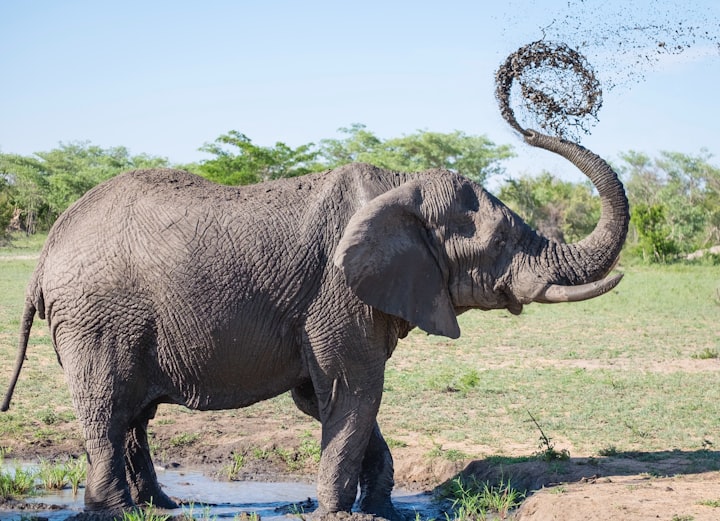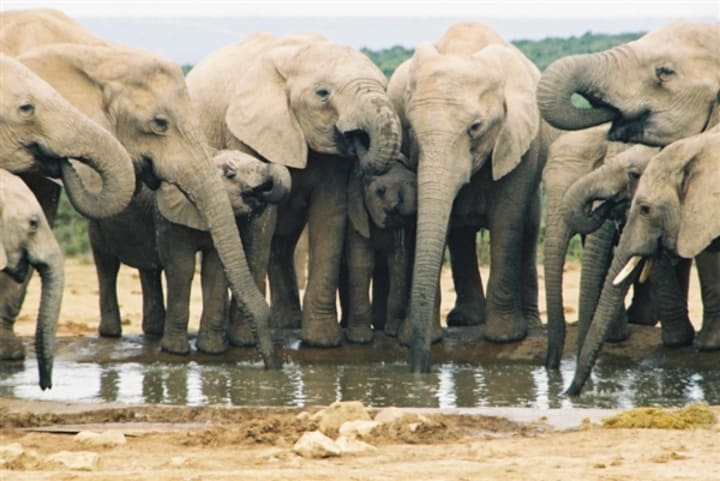Do you all know the function and role of the elephant's trunk?
Elephants belong to the class Mammalia and Proboscis in terms of taxonomy.

The trunk of an elephant is not only a breathing organ and an olfactory organ but also has a tactile function. It can also be used to ingest food, drink water, carry objects and attack, and even communicate feelings and transmit information between individuals; trained elephants, can also hold the harmonica with their noses and play a tune. It is no compliment to say that the elephant's trunk is worthy of its omnipotent tool, with multiple functions.
1. Elephant trunks have a sensitive sense of smell and can smell the taste and danger of food
The end of the elephant trunk has abundant and well-developed microvessels and sensitive nerves. It has a keen sense of smell and touches like a human finger. It can detect external environmental information like radar and transmit it to the brain. Elephants often put up their long trunks and swing in the air to smell hundreds of meters away or even more. It can also judge whether there is danger. Once it finds danger, it either flees against the wind or rushes forward. , a fight to the death. In addition, it can also use its nose to taste whether there is delicious food.

2. The trunk of an elephant can be used for foraging
Elephants' proboscis, like a flexible and delicate hand, can pick up favorite fruits, branches, and leaves, accurately put food into the mouth, can also pick flowers, and even pick up coins. With its extended nose, it can easily swipe the fruit, branches, and leaves from the tree, then roll back its nose and put it into its mouth; if it wants to eat grass on the ground, when it is uprooted, it will slap the soil off its legs and send it back to its mouth. Eat in the mouth; the end of the elephant's trunk is protruding, and there are abundant nerve cells distributed on it.
3. Elephant's trunk can be used to absorb water, drink water, spray water, and bathe
The elephant's trunk can also be used to absorb water. Elephants must use their proboscis to drink water. Instead of sucking water directly with their nose, the water is adsorbed on the front end of the nose and sent into the mouth. Each time it takes a mouthful of water, it will be as much as 5 liters! When the elephant is thirsty, it sticks its trunk into the river water and sucks up the water. It's like a small water pump. After a while, it will drink enough. In this regard, some people may be very suspicious. The elephant trunk is mainly used for breathing. When drinking water with it, will the water not choke into the lungs? This worry is superfluous. It turned out that there is a special piece of cartilage above the esophagus behind the nose of the elephant, which acts like a "valve". When sucking water, the muscles in the throat contract, the "valve" closes, and the water can smoothly enter the esophagus without entering the trachea. After drinking water, squirt out the water remaining in the nose. At this time, the "valve" is automatically opened and breathing is carried out normally. This ingenious structure is wonderful. Elephants cannot live without water. In hot weather, they should suck enough water through their noses and spray them all over their bodies. This is a more convenient bathing machine than a shower. At the same time, elephants also use their trunks to smear mud or sand on their bodies to prevent mosquito bites and protect their skin.

4. Elephant's trunk can be used to defend against enemies
The proboscis of an elephant is like a strong arm, capable of uprooting trees, wrapping up enemies, and even throwing them out. The elephant is easy to deal with those small and weak beasts. Even if it encounters a fierce beast, it is not afraid. It first waved its trunk to beat the opponent, then rolled it up and threw it into the air, and fell half dead. Challenge it?
5. Elephants' proboscis is also a tool for communicating with each other
In the African savannah, it is often seen that two African elephants have their heads close to each other and use their proboscis to wrap around each other, seemingly communicating and interacting. Biologists believe that elephants are highly intelligent animals. They can communicate with each other by touching and stroking each other through their sensitive trunks. In the caves where European prehistoric people lived about 30,000 years ago, woolly mammoths with long trunks wrapped around each other were also found on stone walls. Woolly mammoths could also communicate with each other through their long trunks.

6. Elephants use their trunks to help humans carry
Tamed elephants can easily roll up trees or goods weighing hundreds of kilograms, and one elephant is worth the labor of 20 to 30 people. There are "elephant schools" in Myanmar and Thailand. After the elephant's graduate, they are assigned to "porters" in the deep mountains and old forests.
Why does an elephant's trunk have so many functions and functions?
The proboscis of an elephant can be up to 3 meters long, and the end of the trunk can directly touch the ground. The trunk does not have any bone or cartilage structure. The long trunk is composed of nearly 40,000 small elastic muscles and about 150,000 muscle bundles. Hold up the weight. It has millions of nerve endings, and the nose has one (Asian elephant) or two (African elephant) finger-like protrusions, which have two functions tongue tasting and nose-smelling. Due to the peculiar structure of the elephant's trunk, it has a unique function and is easy to use. The proboscis of an elephant is a very important organ. Once the front end of the trunk is bitten by a crocodile or a carnivore, the elephant will die because it cannot drink water, eat, or lose its keen sensory function.
Although the functions of the trunks of all types of elephants are the same, the protrusions at the ends of the trunks of African elephants, Asian elephants, and woolly mammoths are slightly different. African elephants have a finger-shaped protrusion on the top and bottom of the nose; Asian elephants have only one upper finger-shaped protrusion, and the bottom is thick; in shape.
African elephants have up-and-down finger-shaped protrusions, which are more flexible than Asian elephants to hold grass on the ground or pick up small stones with their fingertips up and down. The woolly mammoth had only one finger-shaped protrusion but was longer and more developed. The protrusion above the tip of the nose wrapped around the food, and the flat lower edge of the nose tip supported the food. The flexibility of feeding is better than that of Asian elephants, and it is not inferior to African elephants.
About the Creator
Flagler Danzig
The talent is 1% inspiration adds on 99% sweat, certainly, does not have that 1% inspiration, in the world all sweat to put or bring together also only is the sweat!






Comments
There are no comments for this story
Be the first to respond and start the conversation.